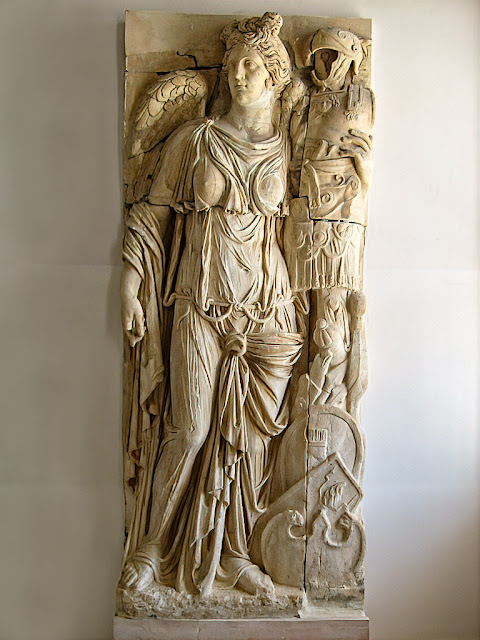Minerva or Bellona?
Despite the Roman association between Minerva and Athena and the frequent depiction of both goddesses with armor, unlike Athena, Minerva was not considered a war goddess in the Roman pantheon. The Romans had their own war goddess Bellona, originally an ancient Sabine goddess of war identified with Nerio, the consort of the war god Mars, and later with the Greek war goddess Enyo.
Bellona's main attribute is the military helmet that was worn on her head much like Athena. Bellona is often depcicted holding a sword, spear, or shield, and brandishing a torch or whip as she rides into battle in a four-horse chariot.
Bellona had a temple near the Theatre of Marcellus dedicated in 296 BCE near the Circus Flaminius by Appius Claudius Caecus, during the war with the Etruscans and Samnites. The Roman Campus Martius area, in which Bellona’s temple was situated, had extraterritorial status. Ambassadors from foreign states, who were not allowed to enter the city proper, stayed in this complex. Since the area of the temple was outside the pomerium, the Senate met there with ambassadors and received victorious generals prior to their triumphs. Beside the temple was the war column (columna bellica), which represented non-Roman territory. To declare war on a distant state, a javelin was thrown over the column by one of the priests concerned with diplomacy (fetiales) toward the direction of the enemy land. This symbolic attack was considered the opening of war.
Bellona's festival was celebrated on June 3, and her priests were known as Bellonarii and used to wound their own arms or legs as a blood sacrifice to her. These rites took place on March 24, called the day of blood (dies sanguinis), after the ceremony. In consequence of this practice, which was similar to the rites of Cybele in Asia Minor, both Enyo and Bellona became identified with her Cappadocian aspect, Ma.
In the military cult of Bellona, she was associated with Virtus, the personification of valour. Her worship by the legions extended her cult into the provinces. Temples to Bellona have been recorded in France, Germany, Britain, and North Africa.
In art, Bellona and Minerva have been frequently confused. French artist Augustin Pajou created a sculpture between 1775-1785 that he dubbed Minerva but bearing the attributes of Bellona. I was surprised on reading the J. Paul Getty Museum's entry for the sculpture stating Minerva was the Roman goddess of wisdom (a shared attribute with Athena) and war (??), striding forward to protect Painting, Sculpture, Music, Justice, and Medicine, the attributes of which lie at her feet. But she wears the helmet and carries the torch of Bellona. A beautiful ancient Roman relief in the Carthage National Museum, however, clearly illustrates the difference between the two deities. In this relief, Minerva stands beside a collection of a warrior's armor (although not the goddess of war, Minerva was considered a patron of warriors) but does not wear a helmet or brandish a weapon or torch.
 |
| Roman relief of Minerva at the Carthage National Museum courtesy of Wikimedia Commons contributor Mourad Ben Abdallah (digitally enhanced). |
"Minerva" by Augustin Pajou at the J. Paul Getty Museum in Los Angeles, California courtesy of the museum.




Comments
Post a Comment